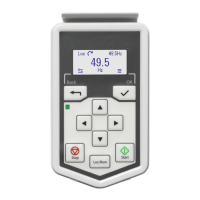Fieldbus control through the embedded fieldbus interface (EFB) 405
Control word and Status word
The Control Word (CW) is a 16-bit or 32-bit packed boolean word. It is the principal
means of controlling the drive from a fieldbus system. The CW is sent by the fieldbus
controller to the drive. With drive parameters, the user selects the EFB CW as the
source of drive control commands (such as start/stop, emergency stop, selection
between external control locations 1/2, or fault reset). The drive switches between its
states according to the bit-coded instructions of the CW.
The fieldbus CW is either written to the drive as it is or the data is converted. See
section About the control profiles (page 407).
The fieldbus Status Word (SW) is a 16-bit or 32-bit packed boolean word. It contains
status information from the drive to the fieldbus controller. The drive SW is either
written to the fieldbus SW as it is or the data is converted. See section About the
control profiles (page 407).
References
EFB references 1 and 2 are 16-bit or 32-bit signed integers. The contents of each
reference word can be used as the source of virtually any signal, such as the speed,
frequency, torque or process reference. In embedded fieldbus communication,
references 1 and 2 are displayed by 03.09 EFB reference 1 and 03.10 EFB reference
2 respectively. Whether the references are scaled or not depends on the settings of
58.26 EFB ref1 type and 58.27 EFB ref2 type. See section About the control profiles
(page 407).
Actual values
Fieldbus actual signals (ACT1 and ACT2) are 16-bit or 32-bit signed integers. They
convey selected drive parameter values from the drive to the master. Whether the
actual values are scaled or not depends on the settings of 58.28 EFB act1 type and
58.29 EFB act2 type. See section About the control profiles (page 407).
Data input/outputs
Data input/outputs are 16-bit or 32-bit words containing selected drive parameter
values. Parameters 58.101 Data I/O 1 … 58.114 Data I/O 14 define the addresses
from which the master either reads data (input) or to which it writes data (output).
Register addressing
The address field of Modbus requests for accessing holding registers is 16 bits. This
allows the Modbus protocol to support addressing of 65536 holding registers.
Historically, Modbus master devices used 5-digit decimal addresses from 40001 to
49999 to represent holding register addresses. The 5-digit decimal addressing limited
to 9999 the number of holding registers that could be addressed.
ACS580 FW.book Page 405 Wednesday, September 21, 2016 9:48 PM

